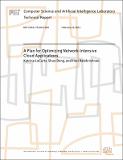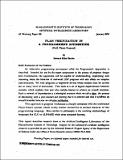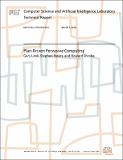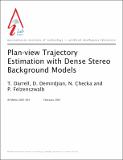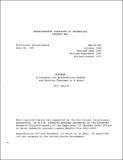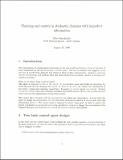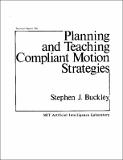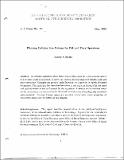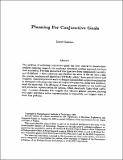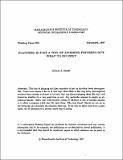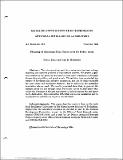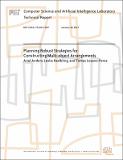Browsing Computer Science and Artificial Intelligence Lab (CSAIL) by Title
Now showing items 2540-2559 of 3804
-
Pilot: A Step Towards Man-Computer Symbiosis
(1966-09)PILOT is a programming system constructed in LISP. It is designed to facilitate the development of programs by easing the familiar sequence: write some code, run the program, make some changes, write some more code, run ... -
PIPES: Linguistic Support for Ordered Asynchronous Invocations
(1992-04)We describe pipes, a new linguistic mechanism for sequences of ordered asynchronous procedure calls in multiprocessor systems. Pipes allow a sequence of remote invocations to be performed in order, but asynchronously with ... -
Plain Talk About Neurodevelopmental Epistemology
(1977-06-01)This paper is based on a theory being devloped in collaboration with Seymour Papert in which we view the mind as an organized society of intercommunicating "agents". Each such agent is, by itself, very simple. The ... -
A Plan for Optimizing Network-Intensive Cloud Applications
(2013-02-12)A significant and growing number of applications deployed on cloud infrastructures are network-intensive. These applications are frequently bottlenecked by the speed of network connections between the machines on which ... -
Plan Recognition in a Programmer's Apprentice
(MIT Artificial Intelligence Laboratory, 1977-05)Brief Statement of the Problem: Stated most generally, the proposed research is concerned with understanding and representing the teleological structure of engineered devices. More specifically, I propose to study the ... -
Plan Verification in a Programmer's Apprentice
(MIT Artificial Intelligence Laboratory, 1978-01)Brief Statement of the Problem: An interactive programming environment called the Programmer's Apprentice is described. Intended for use by the expert programmer in the process of program design and maintenance, the ... -
Plan-Driven Pervasive Computing
(2006-03-01)The goal of human-centered, pervasive computing should be to hide the details of the computing environment, allowing users to concentrate on their goals, rather than on the direct management of devices. This paper describes ... -
Plan-view Trajectory Estimation with Dense Stereo Background Models
(2001-02-01)In a known environment, objects may be tracked in multiple views using a set of back-ground models. Stereo-based models can be illumination-invariant, but often have undefined values which inevitably lead to foreground ... -
Planar Embedding of Planar Graphs
(1983-02)Planar embedding with minimal area of graphs on an integer grid is an interesting problem in VLSI theory. Valiant [V] gave an algorithm to construct a planar embedding for trees in linear area; he also proved that there ... -
Plane Geometry Theorem Proving Using Forward Chaining
(1974-01-01)A computer program is described which operates on a subset of plane geometry. Its performance not only compares favorably with previous computer programs, but within its limited problem domain (e.g. no curved lines ... -
Planner Implementation Proposal to ARPA 1972-1973
(1971-12-01)The task objective is the generalization and implementation of the full power of the problem solving formalism PLANNER in the next two years. We will show how problem solving knowledge can be effectively incorporated into ... -
PLANNER: A Language for Manipulating Models and Proving Theorems in a Robot
(1970-08-01)PLANNER is a language for proving theorems and manipulating models in a robot. The language is built out of a number of problem-solving primitives together with a hierarchical control structure. Statements can be asserted ... -
PLANNER: A Language for Proving Theorems
(1967-07-01)The following is a description of SCHEMATISE, a proposal for a program that proves very elementary theorems though the use of planning. The method is most easily explained through an example die to Black. -
Planning and Teaching Compliant Motion Strategies
(1987-01-01)This thesis presents a new high level robot programming system. The programming system can be used to construct strategies consisting of compliant motions, in which a moving robot slides along obstacles in its ... -
Planning Collision Free Motions for Pick and Place Operations
(1983-05-01)An efficient algorithm which finds collision free paths for a manipulator with 5 or 6 revolute joints is described. It solves the problem for four degree of freedom pick and place operations. Examples are given of paths ... -
Planning for Conjunctive Goals
(1985-11-01)The problem of achieving conjunctive goals has been central to domain independent planning research; the nonlinear constraint-posting approach has been most successful. Previous planners of this type have been comlicated, ... -
Planning is Just a Way of Avoiding Figuring Out What To Do Next
(MIT Artificial Intelligence Laboratory, 1987-09)The idea of planning and plan execution is just an intuition based decomposition. There is no reason it has to be that way. Most likely in the long term, real empirical evidence from systems we know to be built that way ... -
Planning of Minimum-Time Trajectories for Robot Arms
(1984-11-01)The minimum-time for a robot arm has been a longstanding and unsolved problem of considerable interest. We present a general solution to this problem that involves joint-space tesselation, a dynamic time-scaling ... -
Planning Robust Strategies for Constructing Multi-object Arrangements
(2017-01-30)A crucial challenge in robotics is achieving reliable results in spite of sensing and control uncertainty. A prominent strategy for dealing with uncertainty is to construct a feedback policy, where actions are chosen as a ...




